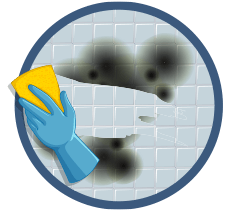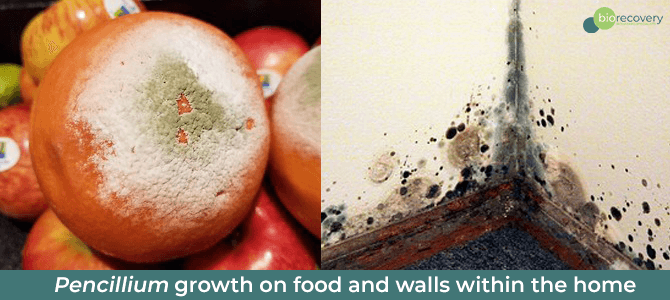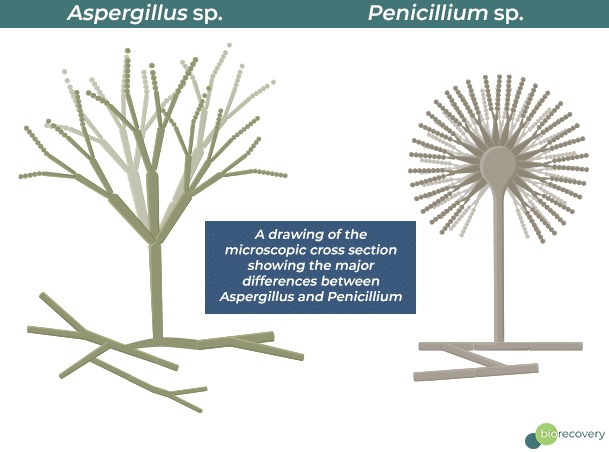Key Points
Where is Toxic Mold Found?
5 Types of Deadly Toxic Mold
Signs You've Been Exposed
How to Get Tested For Mold Toxicity

It’s been estimated that there are over 100,000 species of mold, with a few sources even predicting over three times that amount given how many have yet to be discovered. Thankfully, out of the thousands, there are only five categories of mold known to be toxic to humans and animals:
- Stachybotrys
- Penicillium
- Cladosporium
- Aspergillus
- Fusarium
Naturally, the most common concerns include:
- Common areas they can be found in
- What they are
- What they look like
- How hazardous they are to public health
- What to do if you suspect toxic mold
That may sound scary considering the reputation that follows mold. Truth is we encounter mold of all kinds everyday, it’s just the toxic ones you need to be aware of. The key is always treatment and prevention. Bio Recovery teams have evaluated, identified, and treated these types of mold in our local communities for over 20 years.
As a fully licensed local mold remediation company, Bio Recovery is trained to handle these issues and would like to provide you with helpful tips should you suspect you’re dealing with toxic mold now.
Where is toxic mold typically found?
Mold favors areas that are dark, warm, humid with poor ventilation, however it can technically grow on any surface in any place if the conditions are ideal. Most often, toxic mold growth can be traced back to leaks from within the home. The common areas to look:
- The bathroom (especially the shower, around the toilet, sink, etc.)
- The ceiling
- The walls
- The windows
- Pipes
- Kitchen (e.g. around and under the sink)
- Basement or crawl spaces
- Previously flooded areas
As we’ve said before, mold can technically grow anywhere as long as the conditions are ideal. So it could be beneficial to check your clothes as well, especially if they’ve recently come in contact with flood waters.
Types of Toxic Mold
We hope you didn’t find any mold when you checked these areas–though if you suspect you have, remember that doesn’t automatically mean it’s fatally toxic. According to a recent 2022 survey, 70% of residential homes in America have mold. It’s never pleasant to deal with–especially if you have asthma or respiratory related issues.
Let’s take a look at the common 5 types of toxic mold to see if you’re affected.
Black Mold: Stachybotrys
The number one type of toxic mold that is commonly discussed is black mold. Out of all the categories, Stachybotrys is known to be the worst type. There are several species of Stachybotrys that are generally of the most concern. The two most common are Stachybotrys chartarum and Stachybotrys chlorohalaonata.
What is it?
Stachybotrys colonizes like every other fungal mold growth, spreading on decaying organic matter or damp substances. Stachybotrys, like other species, use the moisture and carbon from the building materials or contents to grow.
Black mold’s reputation emerged during the 1990s after reports of infant deaths attributed to exposure to black mold. Several other reports linked exposure to the idea of “sick building syndrome”. Today, we now know this class of mold emits mycotoxins–harmful toxins called Trichothecenes–which have been identified explicitly as Satratoxin, Isosatratoxin, Roridin, and Verrucarin.
How quickly can it grow?
Black mold can develop within 1-3 days after damp or water damaged conditions develop. It generally becomes most visible after 2-3 weeks.
What does it look like?
It can look different depending on the stage of its growth. When Stachybotrys starts to form it appears white and fuzzy–almost like a cotton ball. Over the course of several days, the mold can turn gray or green with white edges before turning its characteristic blackened hue.
Penicillium
The class of Penicillium has been used in antibiotics that you may have already heard of–penicillin. It was discovered as an effective antibiotic in 1928 when Alexander Fleming, a Scottish microbiologist, noticed that mold inhibited the growth of bacteria. Parts of the mold were since extracted to use in the antibiotic that has since saved millions of lives. So, how is it considered toxic when there are medicinal benefits?
What is it?
The most common species of Penicillium include P. citrinum, P. oxalicum, and P. funiculosum. Like Stachybotrys, these species of Penicillium contain mycotoxins which when airborne can be carcinogenic or cause health symptoms that range from mild to severe, especially for weakened or immunocompromised individuals. These mycotoxins are also responsible for adverse health effects when discovered on or in some processed foods, including cheese and sausages.
In fact, when you think of spoiled, moldy foods, you’re likely thinking of this type of mold. This may possibly be the reason why it’s one of the most common types of toxic mold–with 57% being discovered in all air samples of Canadian household kitchens.
With how prevalent this type of mold is, many as many of us may be exposed to this mold without realizing. That’s why, if you suspect this may be causing any adverse health conditions, it’s important to consider these additional factors:
- Are you immunocompromised?
- Have your symptoms started after a recent move?
- Have you recently found a significant amount of mold in the kitchen, basement, or bathroom of your home?
Typically, it’s only an issue when the growth has reached dangerously high levels–often occurring after a flood or major water damage to a home. The threshold is anything over 1,000 c/m3–that is a thousand spores per cubic meter. In comparison, that would take up 12% of the air in a 10x10 kitchen.
How quickly can it grow?
Penicillium grows rapidly and usually matures within 3-4 days, although some specific species can take up to a week. The ideal conditions for it to grow in include high humidity and temperatures between 41 degrees to 98.6 degrees Fahrenheit.
What does it look like?
Penicillium has distinctive characteristics on food with appearances of white, blue-green, olive-gray, yellow or pinkish. There is a large range of appearances Penicillium may take, all of which vary depending on the type of species.
Cladosporium
Cladosporium is tricky because it doesn’t have mycotoxins like the other classifications. Its spores are only problematic to those that have specific allergies or asthma related conditions. In order to know this is your problem mold, you would want to test your home and have an allergy test done to confirm Cladosporium is the culprit.
What is it?
Cladosporium is another moisture loving, common indoor and outdoor mold. Hundreds of species have been identified as Cladosporium. The airborne spores cause the allergens to serve as irritants to those with severe asthma or respiratory diseases. This is a mold that does produce volatile organic compounds (VOCs) and therefore does emit odors.
Thankfully, it has never been reported to cause a fatal allergic reaction.
How quickly can it grow?
The Cladosporium species tends to grow at a much slower rate than most other molds and its peak growth tends to happen outside during the afternoon. Unlike other species, this mold thrives between 64 to 82 degrees Fahrenheit and can even grow at temperatures as low as 32 degrees Fahrenheit. This is especially the reason why some are prone to allergies during the Spring and early Summer.
What does it look like?
It takes the appearance of black, yellow, or olive green clusters–although it can be brown as well. Cladosporium may also appear as gray clusters depending on the species or where it’s growing.
Aspergillus
You may see Aspergillus and Penicillium categorized together–however, they are two different molds. At a molecular level, Penicillium has a bushy, branched conidiophore (or top spores) and Aspergillus has one straight one with a rounded top that branches out to resemble a dandelion.
The confusion typically comes from the fact that Aspergillus has similarities to Penicillium and do resemble one another. A microscopic cross section shows the major difference between the two, as seen below.
What is it?
Aspergillus is a common type of mold that can treat infections at certain levels and cause infections at other levels. As of 2022, there are currently 837 species of Aspergillus that have been classified. The most serious is thought to be Aspergillus fumigatus. It is thought to be responsible for over 600,00 deaths annually with a mortality rate between 25 to 90%.
The lethal levels of Aspergillus varies depending on the person’s sensitivities, but it appears to be mostly a problem when the mold takes up roughly 8% of an area.
How quickly can it grow?
This mold has an average growth rate of roughly 24-48 hours after incubation. The temperature Aspergillus tends to thrive in is between 54-118 degrees Fahrenheit in hot and arid climates.
What does it look like?
Aspergillus can take the appearance of a variety of colors and shapes. It can appear as a green growth that fades to blue, white, and gray. There are varieties of Aspergillus that have a white, pink, and light brown with white spots in the center. Some species of Aspergillus can also appear to be solid black with white around the corners. Variations of solid dark green or green Aspergillus species are also common.
Fusarium
The Fusarium fungus is a mold that is known to grow on grains and farm fields. In fact, some of what we know about Fusarium are from studies that have been conducted on Finnish farms. Only a few species of Fusarium grow in buildings and residential homes.
In addition to crop disease, what makes this classification dangerous is its ability to produce mycotoxins–or harmful toxins that are potentially pathogenic to humans and animals.
What is it?
Fusarium infects crops and fields, making it a primary issue for farmers and farm staff. Most species of Fusarium have plagued certain crops–a condition that’s been characterized as “Fusarium wilt”. As of 2022, the University of California has been studying the possibility of a gene in Strawberries that appears resistant to Fusarium wilt.
At a molecular level, some may even say Fusarium stays true to its agricultural roots (no pun intended), showing a spindle that resembles a small piece of grain. Indoor species such as F. verticillioides tend to infest soil or basins of stagnant water (e.g. a humidifier or HVAC system).
Some types are a devastating key pathogen to humans and animals. The main active trichothecene is T-2 mycotoxin. This was the same mycotoxin that was for biological warfare by the Soviet Union throughout the 1930s and 1940s.
How quickly can it grow?
As a primarily an issue for farmers or farm staff, only certain species of Fusarium can grow indoors. Indoors species such as F. verticillioides tend to be more tolerant to temperatures higher than 86 degrees Fahrenheit with an approximate 5 day incubation period.
What does it look like?
The Fusarium fungus has distinct fuzzy characteristics with white and brown-beige markings in the middle in most cultures. Fusarium wilt causes plants and fruits to appear purple and rotted. Other manifestations may appear like white mildew. Dark red or browning on the stems of vegetables like tomatoes has also been discovered.
Signs You've Been Exposed to Toxic Mold
Mold symptoms can manifest in a variety of different health effects, many which resemble allergies. These symptoms include:
- Stuffy nose
- Wheezing
- Red or itchy eyes
- Skin rash or irritation
When exposed to certain species–such as cladosporium–these symptoms may be intensified for those who may be immunocompromised, have issues with asthma, or mold allergies.
How to Get Tested for Mold Toxicity
If you’ve been suspecting mold has been causing health problems to your situation, you may have been advised to purchase a DIY mold test. Unfortunately, while this advice may be well intended, there are obvious issues. There are thousands of types of mold, which means an at home test can pick up any species–even the ones that aren’t affecting you.
What you can do instead is check with your doctor to discuss your medical history and request an allergy test or physical exam to rule out the problem.
Here to Help, 24/7
If you discover that you are having a reaction, you may want to call a professional mold remediation company to evaluate, identify, and treat the problem. Bio Recovery is available 24/7/365 to assist you with any help you might need.
Share this Post



